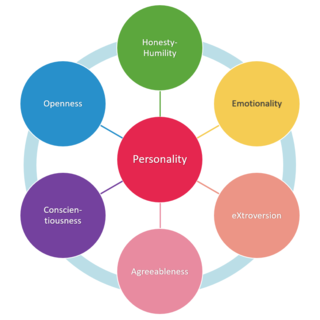A political spectrum is a system to characterize and classify different political positions in relation to one another. These positions sit upon one or more geometric axes that represent independent political dimensions. The expressions political compass and political map are used to refer to the political spectrum as well, especially to popular two-dimensional models of it.

Personality psychology is a branch of psychology that examines personality and its variation among individuals. It aims to show how people are individually different due to psychological forces. Its areas of focus include:

In psychology, attitude is a psychological construct that is a mental and emotional entity that inheres or characterizes a person, their attitude to approach to something, or their personal view on it. Attitude involves their mindset, outlook and feelings. Attitudes are complex and are an acquired state through life experience. Attitude is an individual's predisposed state of mind regarding a value and it is precipitated through a responsive expression towards oneself, a person, place, thing, or event which in turn influences the individual's thought and action.

George Alexander Kelly was an American psychologist, therapist, educator and personality theorist. He is considered the father of cognitive clinical psychology and is best known for his theory of personality, personal construct psychology.
Ambivalence is a state of having simultaneous conflicting reactions, beliefs, or feelings towards some object. Stated another way, ambivalence is the experience of having an attitude towards someone or something that contains both positively and negatively valenced components. The term also refers to situations where "mixed feelings" of a more general sort are experienced, or where a person experiences uncertainty or indecisiveness.

The interpersonal circle or interpersonal circumplex is a model for conceptualizing, organizing, and assessing interpersonal behavior, traits, and motives. The interpersonal circumplex is defined by two orthogonal axes: a vertical axis and a horizontal axis. In recent years, it has become conventional to identify the vertical and horizontal axes with the broad constructs of agency and communion. Thus, each point in the interpersonal circumplex space can be specified as a weighted combination of agency and communion.

The tree of knowledge (ToK) system is a new map of Big History that traces cosmic evolution across four different planes of existence, identified as Matter, Life, Mind and Culture that are mapped respectively by the physical, biological, psychological and social domains of science. The Tree of Knowledge (ToK) System was developed by Gregg Henriques, who is a professor and core faculty member in the Combined-Integrated Doctoral Program in Clinical and School Psychology at James Madison University. The ToK System is part of a larger Unified Theory of Knowledge that Henriques describes as a consilient scientific humanistic philosophy for the 21st Century.

A system is a group of interacting or interrelated elements that act according to a set of rules to form a unified whole. A system, surrounded and influenced by its environment, is described by its boundaries, structure and purpose and is expressed in its functioning. Systems are the subjects of study of systems theory and other systems sciences.
Social perception is the study of how people form impressions of and make inferences about other people as sovereign personalities. Social perception refers to identifying and utilizing social cues to make judgments about social roles, rules, relationships, context, or the characteristics of others. This domain also includes social knowledge, which refers to one's knowledge of social roles, norms, and schemas surrounding social situations and interactions. People learn about others' feelings and emotions by picking up information they gather from physical appearance, verbal, and nonverbal communication. Facial expressions, tone of voice, hand gestures, and body position or movement are a few examples of ways people communicate without words. A real-world example of social perception is understanding that others disagree with what one said when one sees them roll their eyes. There are four main components of social perception: observation, attribution, integration, and confirmation.
A glossary of terms relating to systems theory.
Socio-ecological models were developed to further the understanding of the dynamic interrelations among various personal and environmental factors. Socioecological models were introduced to urban studies by sociologists associated with the Chicago School after the First World War as a reaction to the narrow scope of most research conducted by developmental psychologists. These models bridge the gap between behavioral theories that focus on small settings and anthropological theories.

Organismic theories in psychology are a family of holistic psychological theories which tend to stress the organization, unity, and integration of human beings expressed through each individual's inherent growth or developmental tendency. The idea of an explicitly "organismic theory" dates at least back to the publication of Kurt Goldstein's The organism: A holistic approach to biology derived from pathological data in man in 1934. Organismic theories and the "organic" metaphor were inspired by organicist approaches in biology. The most direct influence from inside psychology comes from Gestalt psychology. This approach is often contrasted with mechanistic and reductionist perspectives in psychology.
Andras Angyal was an American psychiatrist, known for a holistic model for a theory of personality.
The Personality Assessment System (PAS) is a descriptive model of personality formulated by John W. Gittinger. The system has been used by scientists in studying personality and by clinicians in clinical practice. A major feature of the PAS is that a personality profile can be systematically interpreted from a set of Wechsler Scales subtest scores.

The hypostatic model of personality is a view asserting that humans present themselves in many different aspects or hypostases, depending on the internal and external realities they relate to, including different approaches to the study of personality. It is both a dimensional model and an aspect theory, in the sense of the concept of multiplicity. The model falls into the category of complex, biopsychosocial approaches to personality.

The cognitive-affective personality system or cognitive-affective processing system (CAPS) is a contribution to the psychology of personality proposed by Walter Mischel and Yuichi Shoda in 1995. According to the cognitive-affective model, behavior is best predicted from a comprehensive understanding of the person, the situation, and the interaction between person and situation.

Neo-Piagetian theories of cognitive development criticize and build upon Jean Piaget's theory of cognitive development.

The HEXACO model of personality structure is a six-dimensional model of human personality that was created by Ashton and Lee and explained in their book, The H Factor of Personality, based on findings from a series of lexical studies involving several European and Asian languages. The six factors, or dimensions, include Honesty-Humility (H), Emotionality (E), Extraversion (X), Agreeableness (A), Conscientiousness (C), and Openness to Experience (O). Each factor is composed of traits with characteristics indicating high and low levels of the factor. The HEXACO model was developed through similar methods as other trait taxonomies and builds on the work of Costa and McCrae and Goldberg. The model, therefore, shares several common elements with other trait models. However, the HEXACO model is unique mainly due to the addition of the Honesty-Humility dimension.
In personality pathology, dimensional models of personality disorders conceptualize personality disorders as quantitatively rather than qualitatively different from normal personality. They consist of extreme, maladaptive levels of certain personality characteristics. Within the context of personality psychology, a "dimension" refers to a continuum on which an individual can have various levels of a characteristic, in contrast to the dichotomous categorical approach in which an individual does or does not possess a characteristic. According to dimensional models personality disorders are classified according to which characteristics are expressed at which levels. This stands in contrast to the traditional categorical models of classification, which are based on the boolean presence or absence of symptoms and do not take into account levels of expression of a characteristic or the presence of any underlying dimension.
Person–environment fit is the degree to which individual and environmental characteristics match. Person characteristics may include an individual's biological or psychological needs, values, goals, abilities, or personality, while environmental characteristics could include intrinsic and extrinsic rewards, demands of a job or role, cultural values, or characteristics of other individuals and collectives in the person's social environment. Due to its important implications in the workplace, person–environment fit has maintained a prominent position in Industrial and organizational psychology and related fields.













